Multitemporal InSAR Coherence Analysis and Methods for Sand Mitigation
Abstract
:1. Introduction
2. Materials and Methods
2.1. Use Cases Characterization and Datasets
2.2. Methods
2.2.1. Pre-Processing
2.2.2. TSI and MSTC Indexes
2.2.3. Offset Tracking
3. Results
3.1. TSI and MSTC Indexes
3.1.1. UAE
3.1.2. Egypt
3.2. Offset Tracking
3.2.1. SAR Offset Tracking
3.2.2. Comparison with Feature Tracking from Very High-Resolution Images
4. Discussion
4.1. MSTC and TSI Indexes
4.2. Offset Tracking
5. Conclusions
Author Contributions
Funding
Institutional Review Board Statement
Informed Consent Statement
Data Availability Statement
Acknowledgments
Conflicts of Interest
References
- Middleton, N.J.; Sternberg, T. Climate hazards in drylands: A review. Earth-Sci. Rev. 2013, 126, 48–57. [Google Scholar] [CrossRef]
- Hereher, M.E. Sand movement patterns in the Western Desert of Egypt: An environmental concern. Environ. Earth Sci. 2010, 59, 1119–1127. [Google Scholar] [CrossRef]
- Amin, A.; Abu Seif, E.-S. Environmental Hazards of Sand Dunes, South Jeddah, Saudi Arabia: An Assessment and Mitigation Geotechnical Study. Earth Syst. Environ. 2019, 3, 173–188. [Google Scholar] [CrossRef]
- Hugenholtz, C.H.; Levin, N.; Barchyn, T.E.; Baddock, M.C. Remote sensing and spatial analysis of aeolian sand dunes: A review and outlook. Earth-Sci. Rev. 2012, 111, 319–334. [Google Scholar] [CrossRef]
- Yao, Z.Y.; Wang, T.; Han, Z.W.; Zhang, W.M.; Zhao, A.G. Migration of sand dunes on the northern Alxa Plateau, Inner Mongolia, China. J. Arid Environ. 2007, 70, 80–93. [Google Scholar] [CrossRef]
- El-Magd, I.; Hassan, O.; Arafat, S. Quantification of Sand Dune Movements in the South Western Part of Egypt, Using Remotely Sensed Data and GIS. J. Geogr. Inf. Syst. 2013, 5, 498–508. [Google Scholar] [CrossRef]
- Baird, T.; Bristow, C.S.; Vermeesch, P. Measuring Sand Dune Migration Rates with COSI-Corr and Landsat: Opportunities and Challenges. Remote Sens. 2019, 11, 2423. [Google Scholar] [CrossRef] [Green Version]
- Hermas, E.; Leprince, S.; El-Magd, I.A. Retrieving sand dune movements using sub-pixel correlation of multi-temporal optical remote sensing imagery, northwest Sinai Peninsula, Egypt. Remote Sens. Environ. 2012, 121, 51–60. [Google Scholar] [CrossRef]
- Ding, C.; Zhang, L.; Liao, M.; Feng, G.; Dong, J.; Ao, M.; Yu, Y. Quantifying the spatio-temporal patterns of dune migration near Minqin Oasis in northwestern China with time series of Landsat-8 and Sentinel-2 observations. Remote Sens. Environ. 2020, 236, 111498. [Google Scholar] [CrossRef]
- Jian Guo, L.; Capes, R.; Haynes, M.; McMoore, J. ERS SAR Multi-Temporal Coherence Image as a Tool for Sand Desert Study (Dune Movement Sand Encroachment and Erosion). In Proceedings of the Twelfth International Conference and Workshop on Applied Geologic Remote Sensing, Denver, CO, USA, 17–19 November 1997. [Google Scholar]
- Rozenstein, O.; Siegal, Z.; Blumberg, D.G.; Adamowski, J. Investigating the backscatter contrast anomaly in synthetic aperture radar (SAR) imagery of the dunes along the Israel–Egypt border. Int. J. Appl. Earth Obs. Geoinf. 2016, 46, 13–21. [Google Scholar] [CrossRef]
- Moreira, A.; Prats-Iraola, P.; Younis, M.; Krieger, G.; Hajnsek, I.; Papathanassiou, K.P. A tutorial on synthetic aperture radar. IEEE Geosci. Remote Sens. Mag. 2013, 1, 6–43. [Google Scholar] [CrossRef] [Green Version]
- Ferretti, A.; Monti-Guarnieri, A.; Prati, C.; Rocca, F.; Massonnet, D. InSAR Principles: Guidelines for SAR Interferometry Processing and Interpretation; TM-19; ESA Publications: Noordwijk, The Netherlands, 2007. [Google Scholar]
- Bodart, C.; Ozer, A. The Use of Sar Interferometric Coherence Images to Study Sandy Desertification in Southeast Niger: Preliminary Results; European Space Agency, (Special Publication) ESA SP: Noordwijk, The Netherlands, 2007. [Google Scholar]
- Gaber, A.; Abdelkareem, M.; Abdelsadek, S.I.; Koch, M.; El-Baz, F. Using InSAR Coherence for Investigating the Interplay of Fluvial and Aeolian Features in Arid Lands: Implications for groundwater Potential in Egypt. Remote Sens. 2018, 10, 832. [Google Scholar] [CrossRef] [Green Version]
- Kwarteng, A.; Touzi, R.; Aljassar, H.K. Utilization of satellite SAR imagery for mapping sand dunes in Kuwait. In Proceedings of the IEEE Geoscience and Remote Sensing Symposium (IGARSS), Honolulu, HI, USA, 24–28 July 2000. [Google Scholar]
- Sentinel-1 SAR. Revisit and Coverage. Available online: https://sentinel.esa.int/web/sentinel/user-guides/sentinel-1-sar/revisit-and-coverage (accessed on 12 March 2021).
- Bechor, N.B.D.; Zebker, H.A. Measuring two-dimensional movements using a single InSAR pair. Geophys. Res. Lett. 2006, 33, L16311. [Google Scholar] [CrossRef] [Green Version]
- Strozzi, T.; Luckman, A.; Murray, T.; Wegmiiller, U.; Werner, C. Glacier motion estimation using SAR offset-tracking procedures. IEEE Trans. Geosci. Remote Sens. 2002, 40, 2384–2391. [Google Scholar] [CrossRef] [Green Version]
- Liu, F.H.; Zhao, Z.; Jezek, K.C. Synergistic Fusion of Interferometric and Speckle-Tracking Methods for Deriving Surface Velocity from Interferometric SAR Data. IEEE Geosci. Remote Sens. Lett. 2007, 4, 102–106. [Google Scholar] [CrossRef]
- Monti Guarnieri, A.; Tebaldini, S. Hybrid Cramér—Rao bounds for crustal displacement field estimators in SAR interferometry. IEEE Signal Process. Lett. 2007, 14, 1012–1015. [Google Scholar] [CrossRef]
- Prats-Iraola, P.; Lopez-Dekker, P.; De Zan, F.; Yagüe-Martínez, N.; Zonno, M.; Rodriguez-Cassola, M. Performance of 3-D Surface Deformation Estimation for Simultaneous Squinted SAR Acquisitions. IEEE Trans. Geosci. Remote Sens. 2018, 56, 2147–2158. [Google Scholar] [CrossRef] [Green Version]
- Alshehhi, A.; Abdelhamid, G. UAE Space Reconnaissance Center as a Valuable Imagery Resource for Monitoring the Environment; An Investigation on Sand Movement. In Proceedings of the 3rd Map ME Conference, Dubai, United Arab Emirates, 9–11 April 2007. [Google Scholar]
- El-Sayed, M. The nature and possible origin of mega-dunes in Liwa, Ar Rub’ Al Khali, UAE. Sediment. Geol. 2000, 134, 305–330. [Google Scholar] [CrossRef]
- Woods, W.W.; Imes, J.F. How wet is wet? Precipitation constraints on late quaternary climate in the southern Arabian Peninsula. J. Hydrol. 1995, 164, 263–268. [Google Scholar] [CrossRef]
- Lee, J.K.; Kim, J.C.; Kun, J.L.; Belorid, M.; Beeley, P.A.; Yun, J. Assessment of wind characteristics and atmospheric dispersion modeling of 137Cs on the Barakah NPP area in the UAE. Nucl. Eng. Technol. 2014, 46, 557–568. [Google Scholar] [CrossRef] [Green Version]
- Alhosani, N. Modeling and Mapping Sand Encroachment Risk as an Aid for Urban Planning in the United Arab Emirates (UAE). J. Geogr. Inf. Syst. 2018, 10, 699–717. [Google Scholar] [CrossRef] [Green Version]
- Bubenzer, O.; Embabi, N.S.; Ashour, M.M. Sand Seas and Dune Fields of Egypt. Geosciences 2020, 10, 101. [Google Scholar] [CrossRef] [Green Version]
- Gifford, A.W.; Warner, D.M.; El-Baz, F. Orbital observations of sand distribution in the Western Desert of Egypt. In Apollo-Soyuz Test Project Summary Science Report. Earth Observations and Photography, NASA SP-412; El-Baz, F., Warner, D.M., Eds.; NASA Scientific and Technical Information Branch: Washington, DC, USA, 1979; Volume 2, pp. 219–236. [Google Scholar]
- Hassoup, A. Sand dunes hazard assessment in El-Kharga Oasis, Egypt. In Proceedings of the 21st EGU General Assembly, Vienna, Austria, 7–12 April 2019. Geophysical Research Abstracts, 21, EGU2019-1714. [Google Scholar]
- Sansosti, E.; Berardino, P.; Manunta, M.; Serafino, F.; Fornaro, G. Geometrical SAR image registration. IEEE Trans. Geosci. Remote Sens. 2006, 44, 2861–2870. [Google Scholar] [CrossRef]
- De Zan, F.; Monti Guarnieri, A. TOPSAR: Terrain Observation by Progressive Scans. IEEE Trans. Geosci. Remote Sens. 2006, 44, 2352–2360. [Google Scholar] [CrossRef]
- Freeman, A. SAR calibration: An overview. IEEE Trans. Geosci. Remote Sens. 1992, 30, 1107–1121. [Google Scholar] [CrossRef]
- Gomba, G.; González, F.R.; De Zan, F. Ionospheric phase screen compensation for the Sentinel-1 TOPS and ALOS-2 ScanSAR modes. IEEE Trans. Geosci. Remote Sens. 2017, 55, 223–235. [Google Scholar] [CrossRef]
- Manzoni, M.; Monti-Guarnieri, A.V.; Realini, E.; Venuti, G. Joint Exploitation of SAR and GNSS for Atmospheric Phase Screens Retrieval Aimed at Numerical Weather Prediction Model Ingestion. Remote Sens. 2020, 12, 654. [Google Scholar] [CrossRef] [Green Version]
- Bamler, R.; Hartl, P. Synthetic aperture radar interferometry. Inverse Probl. 1998, 14, R1–R54. [Google Scholar] [CrossRef]
- Farr, T.G.; Rosen, P.A.; Caro, E.; Crippen, R.; Duren, R.; Hensley, S.; Kobrick, M.; Paller, M.; Rodriguez, E.; Roth, L.; et al. The shuttle radar topography mission. Rev. Geophys. 2007, 45, RG2004. [Google Scholar] [CrossRef] [Green Version]
- Palmisano, D.; Satalino, G.; Balenzano, A.; Bovenga, F.; Mattia, F.; Rinaldi, M.; Ruggieri, S.; Skriver, H.; Davidson, M.W.J.; Cartus, O.; et al. Sensitivity of Sentinel-1 Interferometric Coherence to Crop Structure and Soil Moisture. In Proceedings of the IEEE International Geoscience and Remote Sensing Symposium, Yokohama, Japan, 28 July–2 August 2019. [Google Scholar]
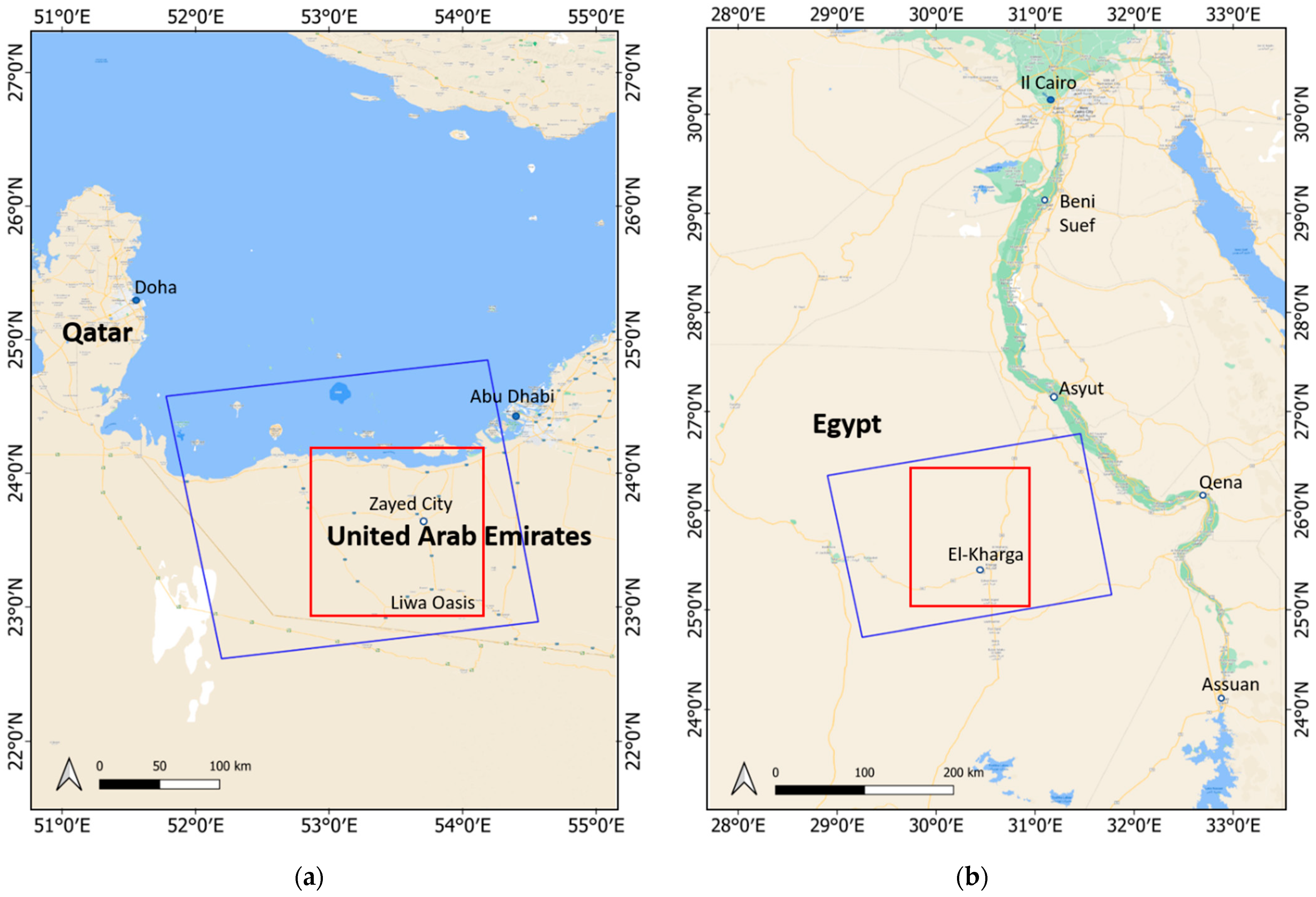
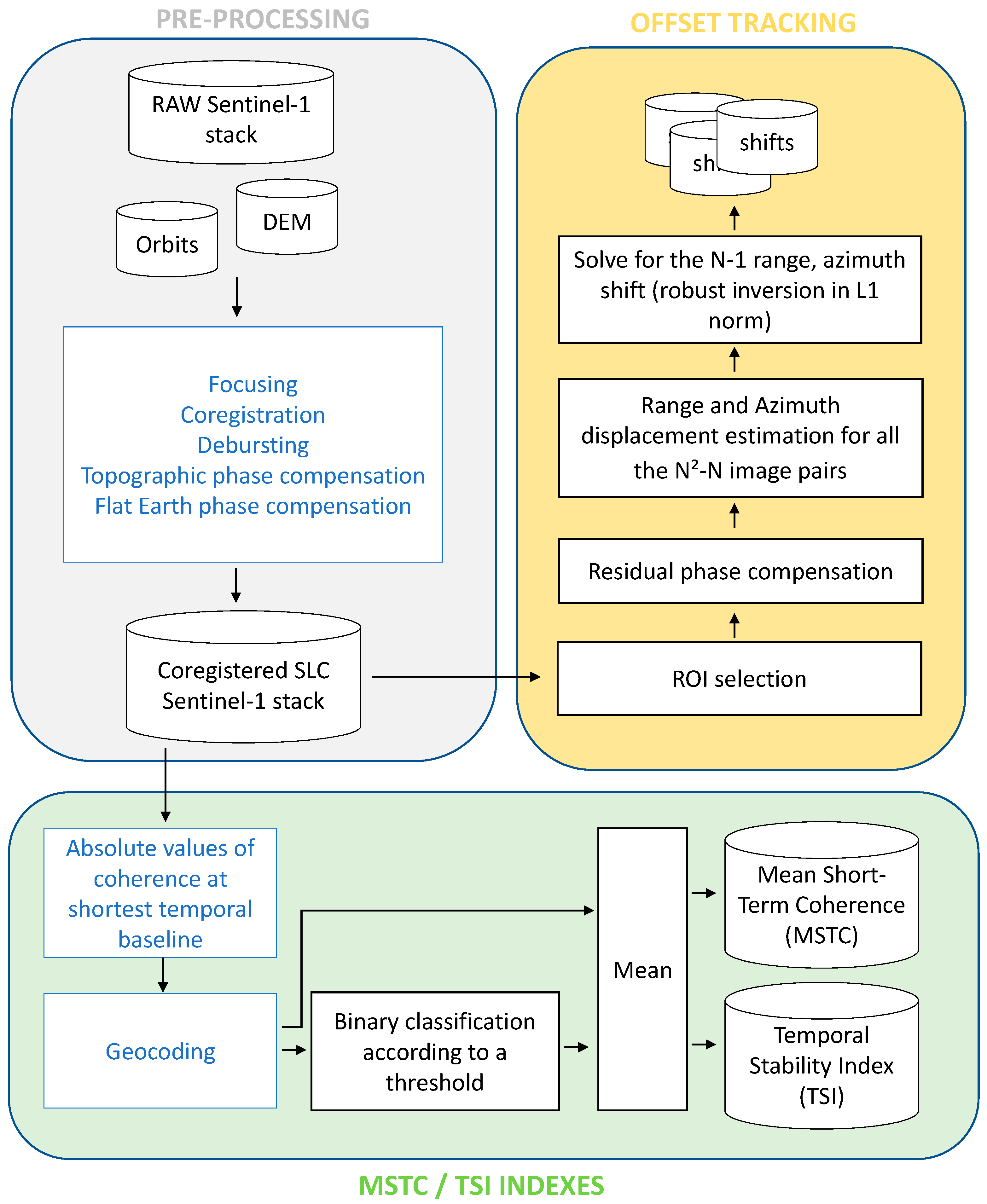


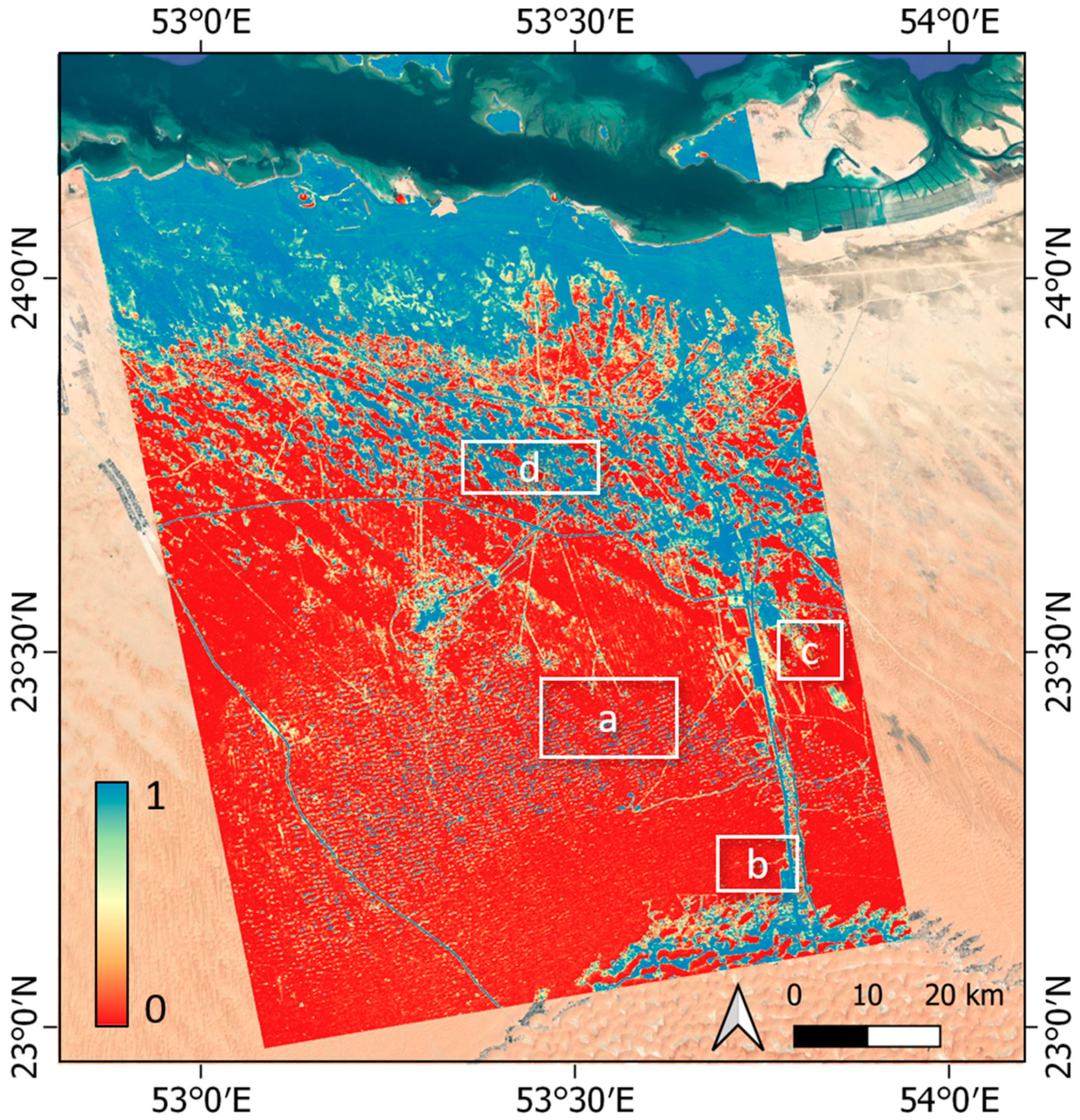

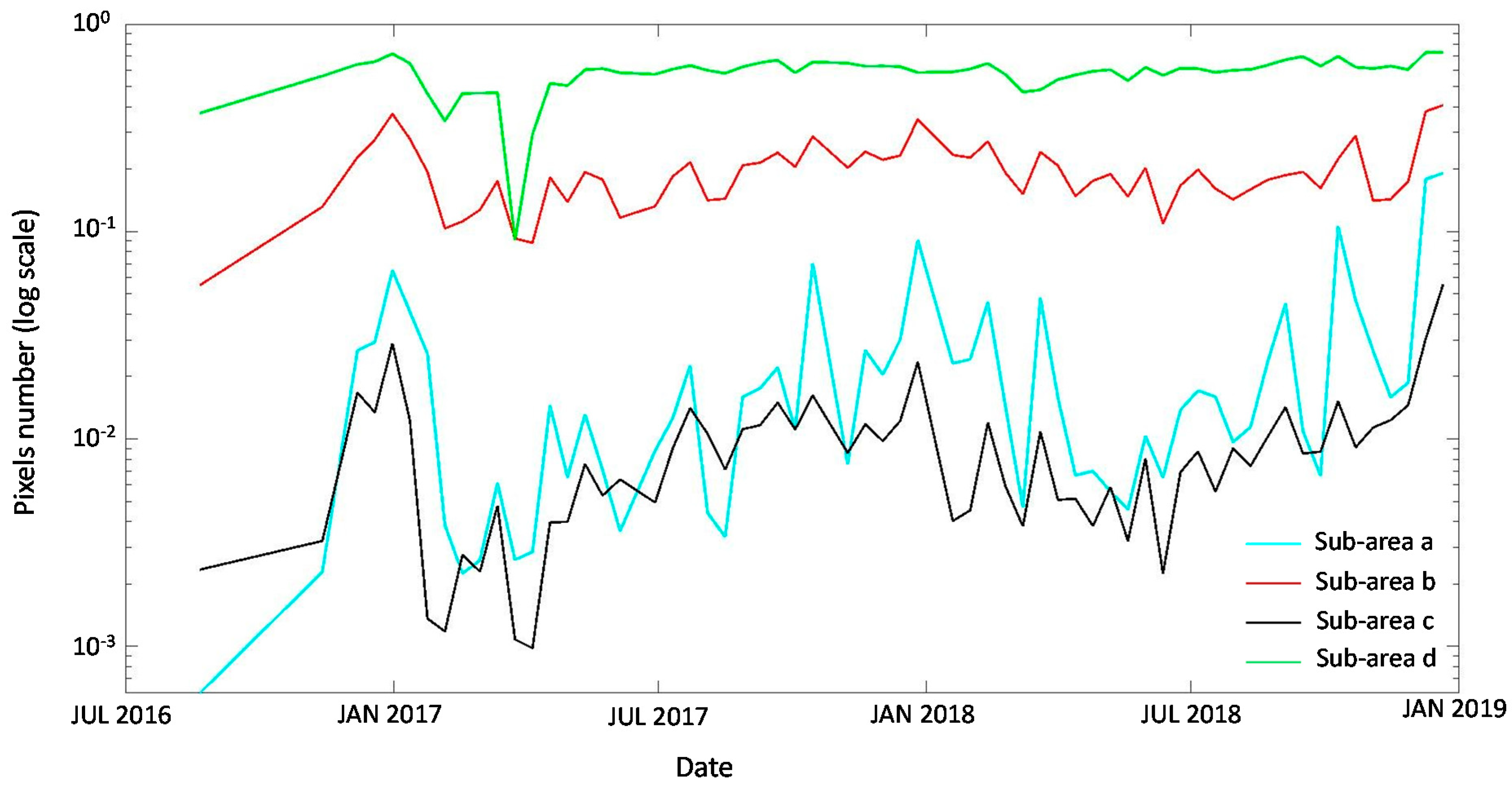

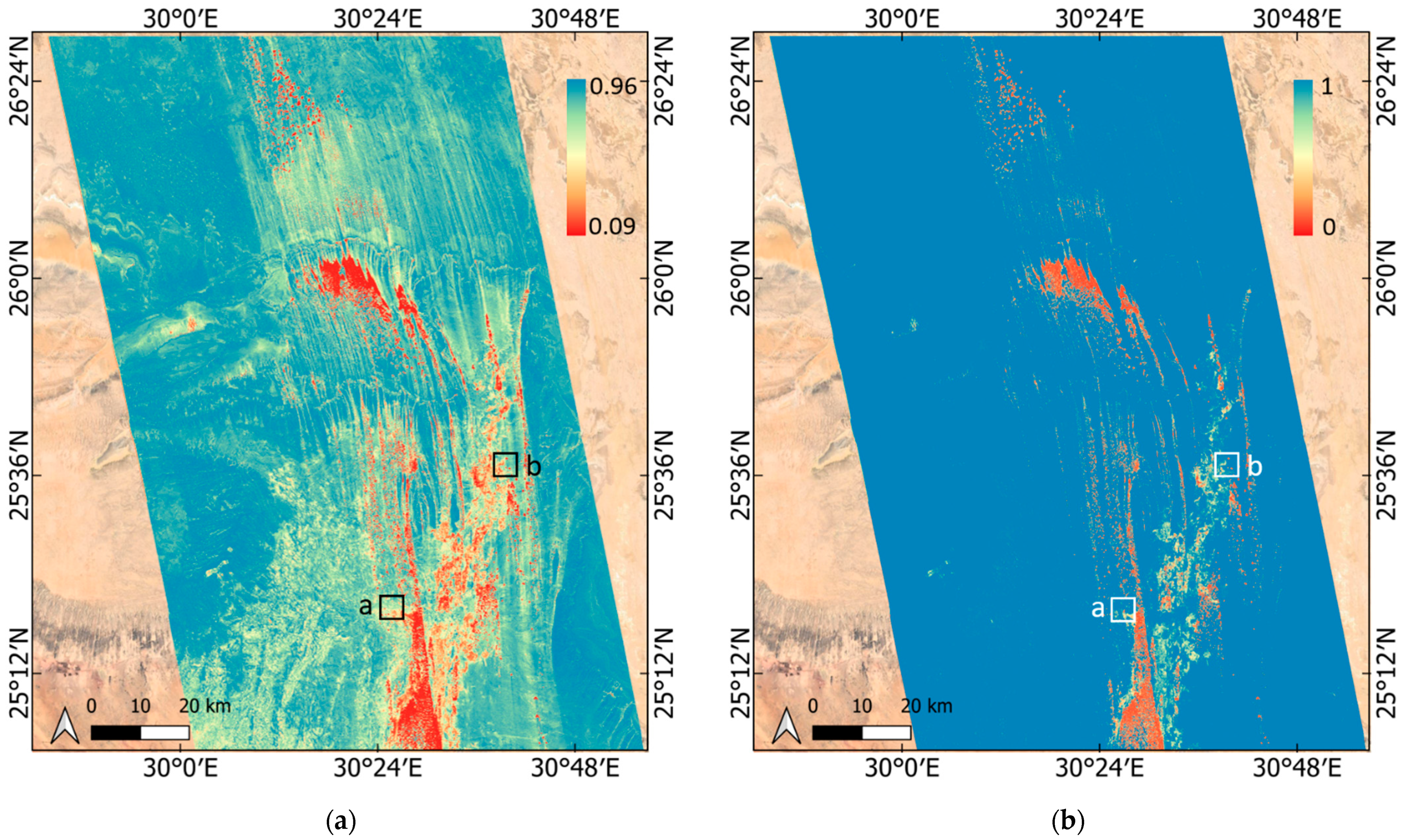

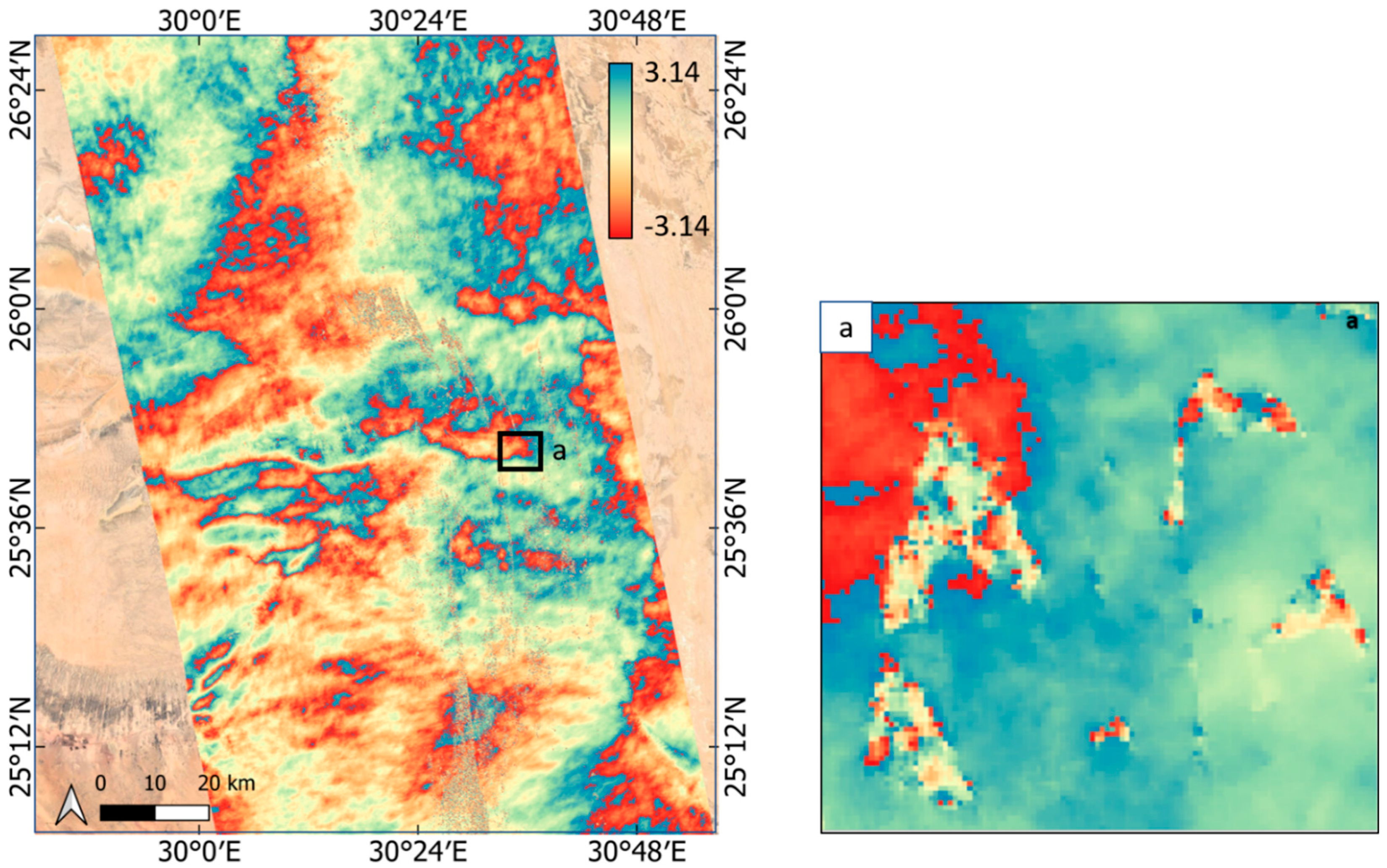

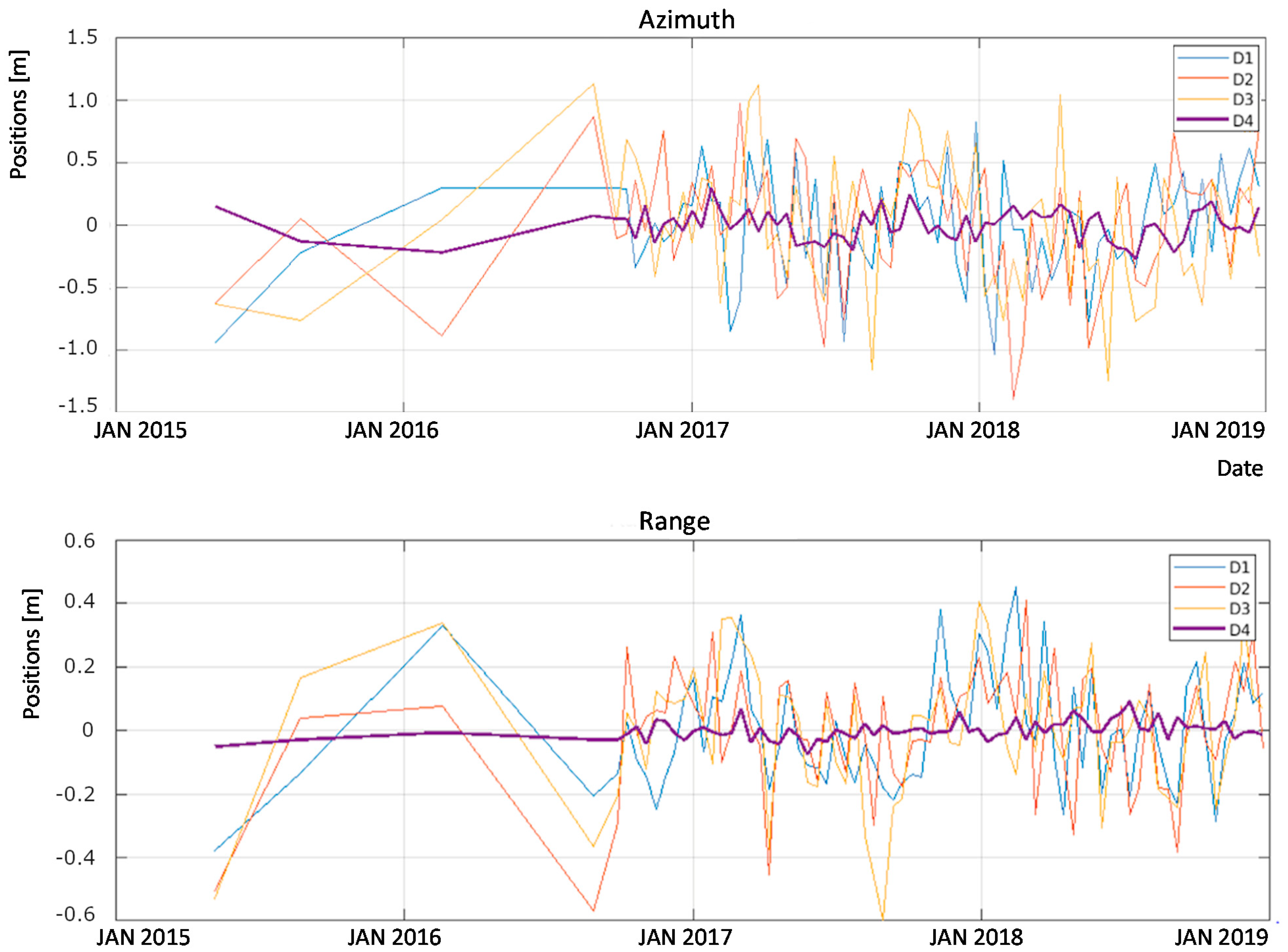
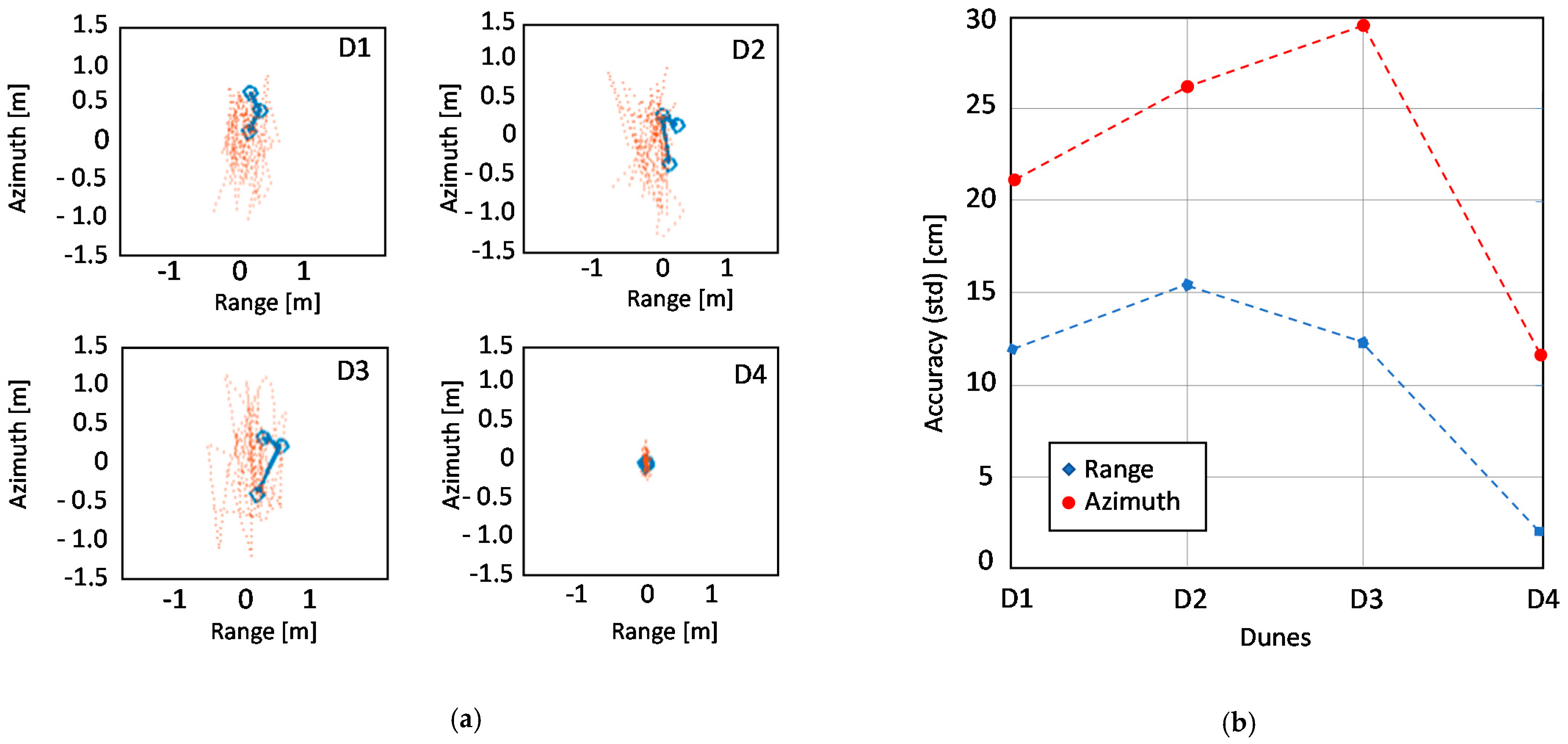
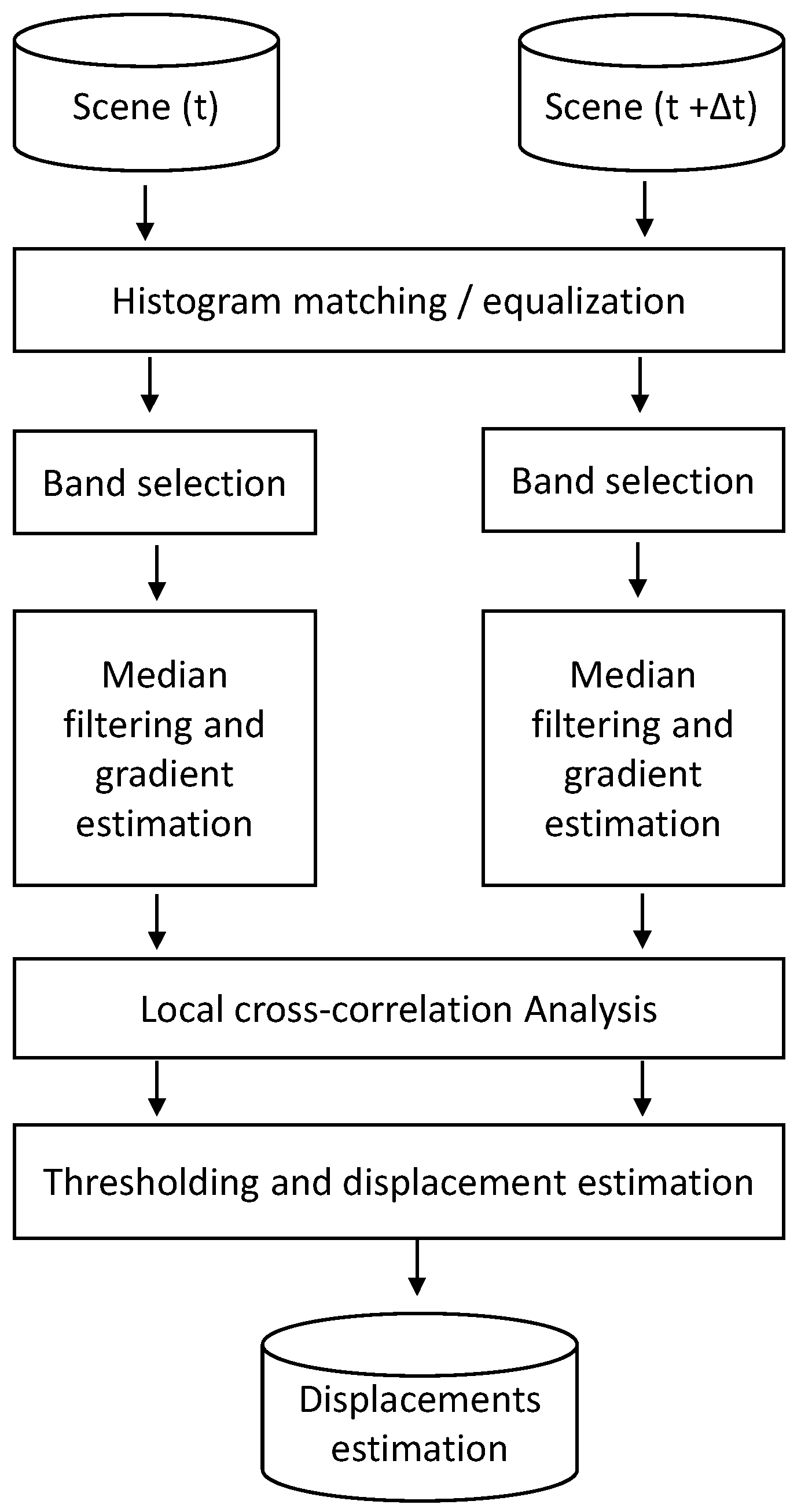
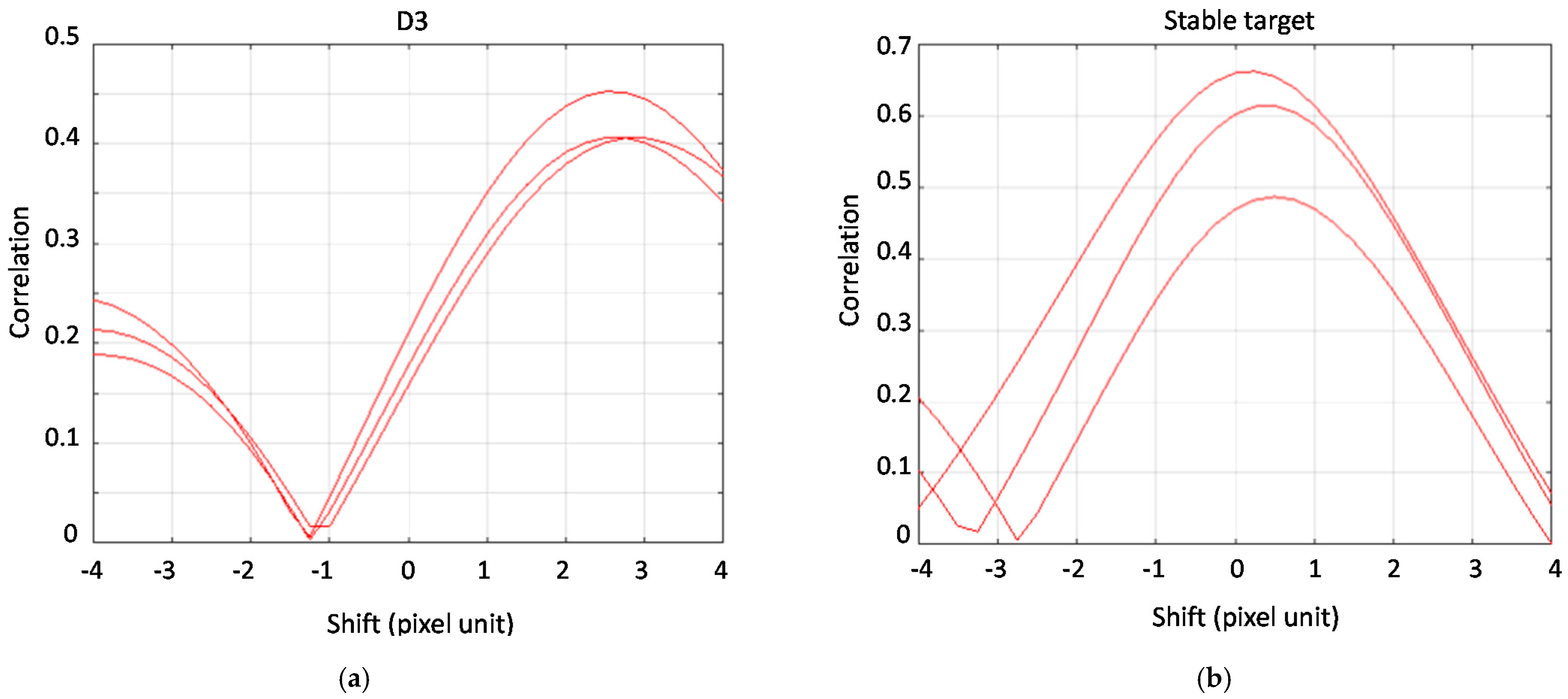

| UAE | Egypt | |
|---|---|---|
| Sensor | Sentinel-1A | Sentinel 1A/1B |
| Relative Orbit | 28 | 131 |
| Frame | 72 | 79 |
| Sub-swath | IW2 | IW2 |
| Pass | ascending | ascending |
| Number of images | 65 | 74 |
| First image acquisition date | 29 April 2015 | 6 May 2015 |
| Last image acquisition date | 21 December 2018 | 22 December 2018 |
| Revisiting time (years 2017–2018) | 12 days | 12 days |
| Scene center (lat, long) | 23.7069, 53.3529 | 25.284, 30.242 |
| Nominal Resolution (azimuth, range) | 20 m × 5 m | 20 m × 5 m |
| Measures | Sensitivity to Changes | Resolution | SNAP Native | Complexity |
|---|---|---|---|---|
| Temporal Stability Index (TSI) | Position (sub cm) | >45 m × 65 m | Partly | No |
| Mean Short-Term Coherence Index (MSTC) | Position (sub cm), topography | >45 m × 65 m | Partly | No |
| Dune offset estimation | Displacements > 10 cm | - | No | Yes |
Publisher’s Note: MDPI stays neutral with regard to jurisdictional claims in published maps and institutional affiliations. |
© 2021 by the authors. Licensee MDPI, Basel, Switzerland. This article is an open access article distributed under the terms and conditions of the Creative Commons Attribution (CC BY) license (https://creativecommons.org/licenses/by/4.0/).
Share and Cite
Manzoni, M.; Molinari, M.E.; Monti-Guarnieri, A. Multitemporal InSAR Coherence Analysis and Methods for Sand Mitigation. Remote Sens. 2021, 13, 1362. https://0-doi-org.brum.beds.ac.uk/10.3390/rs13071362
Manzoni M, Molinari ME, Monti-Guarnieri A. Multitemporal InSAR Coherence Analysis and Methods for Sand Mitigation. Remote Sensing. 2021; 13(7):1362. https://0-doi-org.brum.beds.ac.uk/10.3390/rs13071362
Chicago/Turabian StyleManzoni, Marco, Monia Elisa Molinari, and Andrea Monti-Guarnieri. 2021. "Multitemporal InSAR Coherence Analysis and Methods for Sand Mitigation" Remote Sensing 13, no. 7: 1362. https://0-doi-org.brum.beds.ac.uk/10.3390/rs13071362








